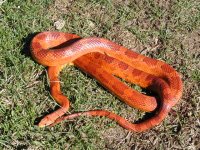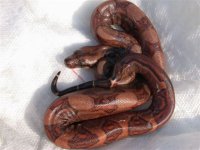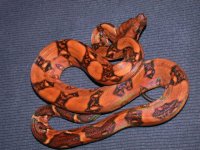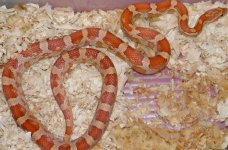ecreipeoj said:
The Miami and Okeetee names are not no-nonnsense names, they are locality names.
To the vast majority of people, including myself, they are nonsense names. It means what someone told me it means, it is completely impossible for me to have a preconceived picture of what to expect. I have never been to Miami or to the Carolinas, let alone gone herping there.

I still feel that there is more to a Bloodred than to a Miami Phase or Okeetee Phase Corn Snake that are selectively bred for that phase, other than the pattern.
This is where we differ. Selective breeding is selective breeding. Whether it's easier or harder to get to the "final" product, or how much of the ideal look is retained in an outcross, has no bearing on anything. It has been shown, pretty clearly, that the pattern trait is independent of everything else we identify with the "bloodred" snakes. All "bloodred" snakes are expressing a mendelian codominant pattern-affecting trait. But not all snakes expressing that trait look anything like the line-bred "bloodred" ideal, or carry any of the additional "line-bred" qualities.
All amels come from the same common ancestor, but since they have been bred outward, and line-bred, in different directions, they have taken on several classes of looks, and each of them has been recignized as "different." They weren't different in the beginning, why are they different now? Why should all corns homozygous for a pattern mutant be any different?
I am beginning to think that the co-dominant pattern trait of Bloods (diffused appearance) is linked to a co-dominant color trait, much like Stripes and Motleys are linked to a recessive mild hypo effect trait. I have no proof of this obviously except just about all corns from the Blood line are a darker shade of red, and there is something else about them that I can not really describe. It is the same kind of proof that we have that Motleys and Striped are lighter. They just all are.
I also disagree here. (But neither of us has "the" answer so we are both doofuses to argue over it, LOL.) I think motleys and stripes are lighter because their pattern is changed. An additional "hypo gene" that tags along is not necessary to explain why motleys are lighter. The lightening is an integral part of what is happening to create the mutant pattern. Either way, if it is linked, it doesn't change anything... they breed the way they breed, which is, for all practical purposes, like a single-gene trait.
The same applies to the diffused gene and its effect on side-patterning. The selective breeding "for a specific ground color" and independently "for an intensity of pattern expression" are what determine whether the snake then becomes a uniform color or not. When you look at individuals that are sufficiently outcrossed and are "unrelated" to the original lines, this becomes fairly obvious.

A Snow Blood from a Blood line will be expected to produce an Amel Blood in the Amel phenotype and a Blood in the normal phenotype.
I would agree with you,
if that were modified to "Snow Diffused, from bloodred lines" and if it's from a line where they were actually line bred. They aren't. Practically every specimen in captivity was outcrossed from the original line. Or so I have been told.
My snake, Mary, was the result of a pewter X Anery cross. The Pewter did not have two "bloodred" parents. He was the result of outcrossing. Meanwhile the anery obviously was not the result of line breeding. Mary was not the result of "line breeding" by any stretch of the imagination. She was the result of at least two outcrosses.
Mary was then crossed to a completely unrelated amelanistic male to produce yet another non-line-bred generation. Two of those siblings were crossed to produce the snows and anerys that I am saying are most definitely in no way, shape, or form "blood" anything. There hasn't been a "blood red" ancestor for at least 5 generations, and there has been no selection toward that end. It is pretty obvious that none of these snakes carry the elements of selective breeding that would be necessary to reproduce the classic "bloodred" snakes. If you were to assume the Pewter and Anery were as closely related to Bloodreds as possible, the best-case scenario, 3/4 of their ancestry has nothing at all to do with "bloodred" lines.
The only thing they have in common with any line-bred "blood red" cornsnakes is that they are expressing the same single-gene pattern trait. They should not be called "blood red" nor should any of their progeny, unless a serious line-breeding program is used to get the "line-bred" qualities back into them.
I like Avalanche Corns for Snow Bloods very much, but the genetic listing should be Avalanche Corns (Anerythristic A, Amelanistic and Blood) They are from the Blood line and have a diffused looking pattern. They are not from the Diffuse line. It does not exist.
As I demonstrated above, you may be able to trace their ancestry back to a distant "blood" ancestor, but these are definitely not "blood" by any stretch of the imagination. If you want to make a listing like that and include selective breeding, the accurate way to do it would be "Amel, Anery, Diffused, from Bloodred lines." Otherwise, again, it is like saying "Anery, Candycane."

These low quality Bloods are still from the Blood Line and I do not see any reason for them to be put into a secondary new line we call “Diffused“.
That's one of the problems we have. You see them as "low quality bloods." (You try not to phrase it that way but it's still the way you see them, hehe.) I don't think Candycanes are "low quality Reverse Okeetees," I think they are candycanes. I don't think a regular amelanistic corn is a "bad" something, it's just an amel. A normal is not a "bad okeetee" it's a normal.
But this is the problem... people have spent 20 years thinking that "bloodreds" (which includes everything that is expressing the diffused mutant pattern trait, or anything related to them) are supposed to all be red. The "red" has nothing to do with the pattern trait, so why judge all specimens expressing a pattern trait based on how red they are? This is like judging the "quality" of an amel based on the thickness of the borders. Had we done that, there would never be anything but reverse Okeetees... candycanes and sunglows would have all been culled for being "ugly." I think people are totally missing out by all trying to keep all "bloodreds" (and anything related to them) as red as possible. Their loss. :grin01:
I definitely do not think that a perfect Blood, that happens to be an Anery, Anery B, Caramel, or Lavender mutant, should be put into a line called “Diffused” because they are not red like the Normal Blood phenotype parents they came from.
Blood or Bloodred does give someone the image in their minds that they will be seeing a red snake, but Blood/Bloodred has more meaning than that. It is the name of a Line of Corns just like Okeetee or Miami. Perhaps they are no-nonsense type names, but they are the names of a Line of Corns that have been line bred for many generations.
For the snakes that are actually part of that line of corns, I agree. I always have said that blood red corns should be called "bloodred" corns.
But people want to take all value out of the name by applying it to anything and everything that has even 0.0001% of ancestry involved in the original line-bred bloodreds, no matter how it looks, no matter what has actually been selected for, or how many times it has been outcrossed.
I can't imagine trying to have this conversation with Okeetee buffs... they know that their snakes are special and want to protect that by not having people call everything under the sun "okeetee."

If Bloodreds had been discovered on an island and they all looked at least somewhat that way, you can bet that any snake with any blood coming from somewhere else, would be considered "impure" and "outcross" and people would be arguing that calling anything but pure specimens by the same name would ruin the whole thing.
I do find it amusing that I'm the one with the "crummy" specimen and I am arguing that "crummy" specimens should
not be included as part of the "more valuable" morph class. Usually it's the other way around where people are trying to convince themselves (and others) that their average-looking normals really are "Okeetee" corns.














